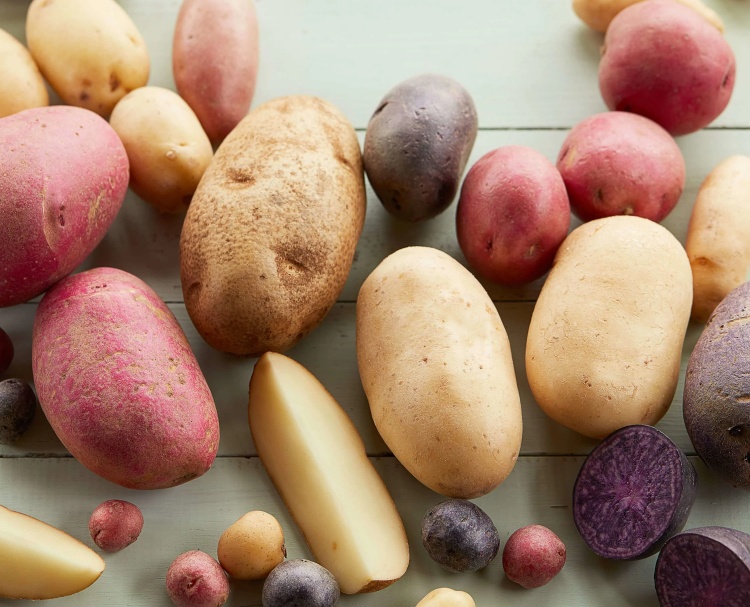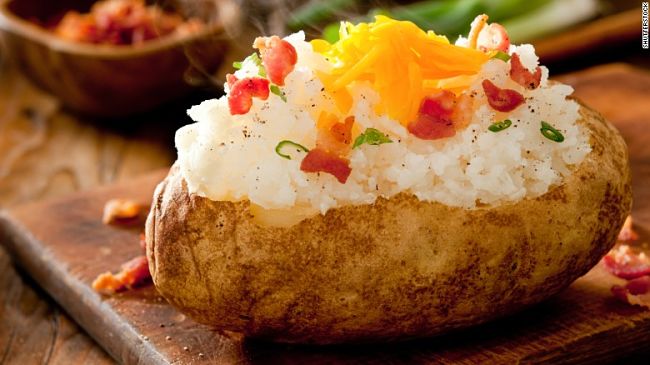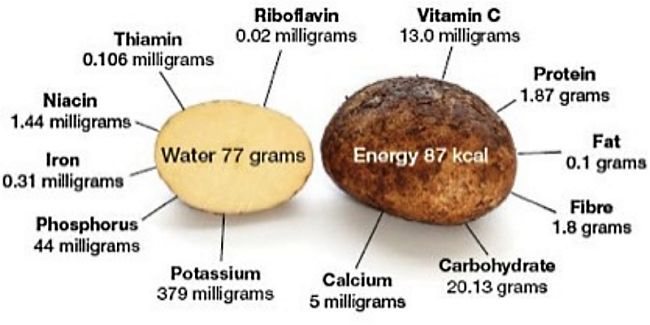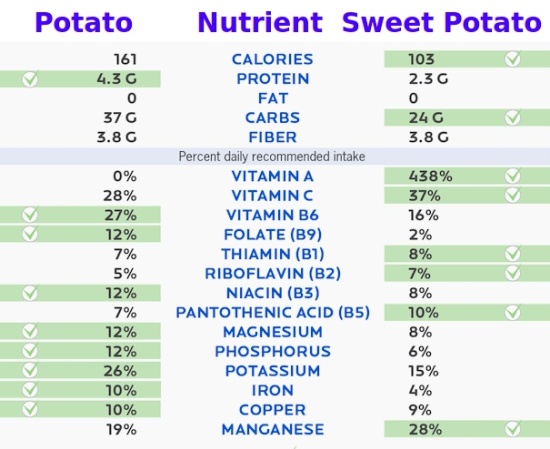Are Potatoes Good for You? Facts, Tips, Healthy Potato Recipes and Types/Uses
Potatoes have gone from being regarded as a super cheap and convenient health food to a junk food that must be limited in the diet. Potatoes need a better promotion manager. Recently the US Congress blocked plans by the United States Department of Agriculture (USDA) to limit servings of potatoes served in school lunches to twice a week.
The same thing applied to starchy vegetables like peas, corn and lima beans but why pick on the humble potato - a fabulous cheap, healthy and versatile food.
The potato, that originated in South America, has a history as a wonderful basic staple food that saved many countries from starvation.


History of the Humble Potato
The introduction of the potato into to Europe literally transformed agriculture. Its importance was dramatically shown by the famine that arose in from the Potato Blight.
In Ireland, during the Great Famine from 1845 to 1852 about 1 million people died and thousands more emigrated from Ireland due to the famine. The primary cause of the terrible famine was the potato disease known as potato blight. This disease ravaged potato crops throughout most of Europe, but had a massive impact on Ireland because about 30% of the population was virtually dependent on potatoes for food.
Prior to the introduction of the potato, people in Ireland and Europe depended mostly on various grain crops which were very unreliable due to the a cold and wet climate and unsuitable soils rocky soil. The potatoes literally allow the population to bloom - birth rates rose, there was a fall infant mortality, women had more babies and most of this can be attributed to the potato. Potatoes could be grown in a wider variety of soils and condition that were unsuitable for growing grains. They could be harvested easily and they required little processing once grown, and they could be stored easily.
Importantly potatoes are packed with wonderful array of nutrients and lots of energy. For a medium size baked potato weighing about 5.3-ounces there is only about 100 calories and little or no fat. The humble potato is one of the richest sources of potassium for any food, including bananas, and is also a wonderful source of fibre and vitamin C.
Potatoes Reputation Defamed but are we throwing out the baby with the bathwater?
Recently, potatoes have suffered from a poor public relations image. Diets like South Beach Atkins put potatoes on the banned list, because of their carbohydrate content. Potatoes were labelled as empty calories with low nutritional value. Because most modern people ate them as deep fried chips or fries, which dramatically increased their fat content, or they were not eaten as a whole food they were labelled as bad for you. Most people removed the skin by peeling and this removed most of the nutrients which were associated with the skin and the layer beneath it.
Nutrients in Potatoes
The major nutrients in a standard white potato (200g), baked, just the flesh.
Carbs: 43 g
Fat: 0.2 g
Protein: 4 g
Fiber: 3 g
Magnesium: 50 mg
Vitamin C: 20 mg
Copper: 0.43 mg
Potassium: 782 mg
These nutrients are certainly much better than rice. The carbohydrates are almost all starch.
The full list of nutrients in potatoes are shown in the images.
Interesting Facts about Potatoes
- In 1995 potatoes became the first food grown in Space aboard the space shuttle Columbia.
- Potato crystals were used to develop the first colour photography
- Biodegradable plastics can be created from potato starch
- Potatoes are cheap and very easy to grow and many people use them as a foundation crop to start a vegetable garden.
- They are and ideal crop for farmers in the developing world.
- Potatoes can grow to a very large size, with the world’s largest potato weighing about 18 pounds (Guinness Book of World Records).
- The Inca populations of Peru were growing potatoes as far back as 200 BC. They were first introduced into Ireland and Britain in the late 1500s.
- At one time, the Scots refused to eat potatoes, because they were not mentioned in the Bible!
- Potatoes were often eaten aboard ship to prevent scurvy, a disease caused by a deficiency of vitamin C.
- There are more than 100 potato varieties of potatoes that are eaten that range from white to red and blue.
- The potato harvest is the fourth largest food crop in the world that is cultivated in a huge array of countries. Only corn, wheat, and rice are more important.
- Americans love potatoes and most people consume about 125 pounds of potatoes each year in the form of fresh, frozen, chips and dehydrated.
- Early varieties of potato mature in less than 90 days
- Late varieties of potato need 110 days or more of growing time, but they typically produce a heavy set of tubers that keep well in storage.
- Potatoes are good for you as long as you prepare them in a healthy manner. Boiled and baked potatoes are good for you. Eat the Skin, Skip the Toppings - don't fry them.


Why are Potatoes Regarded as Unhealthy ?
The biggest issues for the health of potatoes is the way they are prepared. Most people peel off the skins, then boil them or shallow fry them and then develop a sauce that includes salt, cream, butter or milk.Commonly potatoes are baked and a dressing is provided that contains cheese or cream, mayonnaise, bacon bits and other ingredients.
The skin is one of the healthiest parts of the potato should be retained to increase the nutrients. Deep frying potatoes loads them with fat and calories. There are many healthy potatoes recipes to try.
My favourite way to eat potatoes is to simply place washed potatoes on the shelves in the oven and bake for about an hour - Add nothing. This is the perfect baked potato!
Types of Potatoes and Their Uses
There are many potato varieties that can be classified into several major types in terms of their use. The key aspect is the texture when cooked which depends on their starch content. So-called 'waxy' potatoes with low starch are great for boiling and steaming and for potato salads as they hold their shape well when cooked. At the other end of the spectrum is the 'floury, fluffy, dry or starchy' potatoes that are granular and fluffy when cooked making them ideal for roasting and frying.
The guide below outlines the types and the varieties that are available in the UK (and Europe), US and Australia:
Low Starch (“Waxy”) Potatoes
These have starch cells that are loosely packed and these cells stay bound together when cooked. They are ideal potatoes for boiling or steaming for use salads, soups, potato salads, stews and casseroles.
US/UK varieties: charlotte, Ayrshire, Jersey Royals, cornish kings, anya
Australian varieties: Also called “New” potatoes; chat and baby potatoes (smaller versions of most varieties that have yet to developed their starch levels); purple congo; white star.
Round white potatoes: These are medium-sized, round, light tan colored potatoes with a waxy to creamy texture. They are moist with low to medium starch levels and they hold their shape after cooking. They are ideal for boiling, mashing, roasting and frying. US varieties include: Kennebec, Superior and Atlantic.
Round red potatoes: Also called red bliss or 'new' potatoes. They are round, medium-sized, with a dense, crisp white flesh. They are low in starch and quite sweet. They are great whole or halved, for boiling, sautés, stews, salads, roasting, grilling and au gratin dishes. You can serve round reds cooked whole. US Round red varieties include Red Pontiac and Red Norland.
Purple potatoes, blue potatoes and Heirloom Potatoes: These colored potatoes have delicate flavors delicate flavors. They all have low starch levels and can be boiled, steamed, mashed, roasted, fried and used when making stews, salads, and au gratin dishes. Purple and Blue potatoes are probably derived from the original potatoes endemic to Peru. Varieties include: All Blue, Purple Viking, Huckleberry and Blossom.
New Potatoes (Baby, Creamer Potatoes): These terms are used for any variety of juvenile potatoes that are harvested early when small, and to small potato varieties (Baby Reds)) New potatoes are also called baby potatoes and sometimes creamers. New potatoes are harvested before they have time to convert their sugar into starch. New potatoes are low starch, waxy, thin skinned and very moist. They are ideally for cooking whole - boiled, steamed, or pan roasted. They keep their shape well after cooking and are ideal for use in potato salads and stews.
Middle Starch Level Potatoes
These potatoes have moderate starch levels, and so they are all-purpose potatoes, good for both boiling, frying and roasting.
US/UK varieties: desiree, rooster, osprey, yukon gold, kestrel, elfe
US Yellow potatoes: These potatoes are generally oval, round, or slightly oblong in shape. They have thin, yellow or light brown skins. The flesh is generally butter to yellow in color. The golden flesh is waxy. These potatoes have medium to low levels of starch. They have a creamy moist and rather succulent texture with a butter-like flavor. They are ideal for roasting, grilling, steaming, boiling, barbecuing, grilling, mashing and au gratin dishes. Yellow varieties include: German Butterball, Yellow Finn, Yukon gold, Nicola, Carola,and Alby’s Gold.
US Long white Potatoes: These potatoes are also known as "White Rose" or "California Long Whites". They have thin skin which is ivory white to pale gray- or brown skin color. They have an elliptical shape or fat rod shape. Long whites have a low to medium starch content and are moister compared with standard russet potatoes. Long whites keep their shape when cooked and are suitable for baking, steaming, boiling or deep frying.
US Fingerlings: These are New Potatoes as described above. Fingerling varieties include long white fingerlings, Russian banana fingerlings, Ruby crescent fingerlings,and purple Peruvian fingerlings.
Australian Middle Starch Level Potato Varieties: pontiac, rodeo, Kestrel, golden delight, coliban, kipfler, sebago, mozart, toolangi delight.
High Starch Level Potatoes (that is "Dry, Starchy, Fluffy")
These potatoes have densely packed starch cells. These starch cells disperse when cooked, producing a dry, fluffy and grainy texture. They are ideally suitable a roast potatoes, chips, fries, wedges and mashed potato. They are unsuitable for stews, soups and potato salads.
US/UK varieties: king edward, maris piper, russet, burbank, vivaldi
US Russet potatoes: These are one of the most widely available potatoes. They are also known as 'Old Potatoes', 'Baking Potatoes' and 'Idaho Potatoes'. There are oblong, or elliptical in shape. They have brown skin and white flesh. They have high starch and low moisture and so when cooked they become up dry and fluffy. They are ideal for deep frying (French fries), roasting in their skins, baking, grilling and mashing. Top varieties are: Russet Norkotahs, Russet Burbank, Russet Arcadia, and Russet Butte.
Australian varieties: king edward, carisma, dutch cream, royal blue, russet, burbank
Best Ever Recipes for the Cooking Methods
Healthy Potato Salad Recipe
Ingredients- 1 teaspoon sugar
- 1/2 teaspoon salt
- 1/4 teaspoon pepper
- 2 celery ribs, chopped
- 1 teaspoon ground mustard
- 2 teaspoons cider vinegar
- 3/4 cup fat-free mayonnaise
- 1 large sweet onion, chopped
- 1/2 cup chopped green onions
- 2 pounds small red potatoes, quartered 5 hard-cooked eggs
- 1/2 cup juliehned sweet red pepper 1/4 cup minced fresh parsley
Place the potatoes in a pan and just cover with water. Bring to a boil. Then, reduce heat to a simmer; cover and cook for 12-14 minutes or until tender. Drain; cool for 30 minutes. Slice eggs in half (discard yolks or save for another use). Cut the whites into small pieces. Using a large bowl, mix the mayonnaise, vinegar, sugar, mustard, salt and pepper. Add the celery, green onions, potatoes, egg whites, onion, red pepper and parsley; toss to coat. Cover and refrigerate for 2 hours or until chilled.
Healthy Roast Potatoes Recipe
Ingredients- Pinch of dried sage
- Pinch of dried thyme
- 1 clove of garlic (crushed) Salt
- 10 Baby New Potatoes 1 tbsp sunflower oil
Pre-heat your oven to 200 degrees C/400 degrees F. Part cook the potatoes in boiling salted water for ten minutes. Drain them well. Add the sunflower oil, sage and thyme to a large bowl and mix well. Season with salt. Mix in the potatoes and mix thoroughly but carefully to ensure they are all well and evenly coated in the oil and herbs. Put the potatoes on to a baking tray and in to the oven for twenty-five minutes. Do not wash the bowl! Put the crushed garlic in to your unwashed bowl and after twenty-five minutes in the oven, remove your potatoes and put them back in the bowl. Again, stir carefully and well. Put them back on the tray and give them five more minutes in the oven.
Crispy Potatoes with Spicy Tomato Sauce
Ingredients- 1/2 teaspoon salt, divided
- 1/2 teaspoon crushed red pepper
- and cut into 3/4- to 1-inch cubes
- 1/4 teaspoon freshly ground pepper
- 1 1/2 pounds new or baby potatoes, scrubbed
- 1 teaspoon plus 2 tablespoons extra-virgin olive oil, divided 6 cloves garlic, minced
- 1 15-ounce can crushed tomatoes, preferably fire-roasted 1/2 teaspoon smoked paprika
Heat 1 teaspoon oil in a medium saucepan over medium heat. Add garlic and cook, stirring, for 1 minute. Add tomatoes, paprika, crushed red pepper and 1/4 teaspoon salt. Adjust heat so the sauce is simmering and cook, stirring occasionally, until thickened to the consistency of ketchup, 16 to 20 minutes. Meanwhile, toss potatoes, pepper and the remaining 1/4 teaspoon salt in a medium bowl. Heat the remaining 2 tablespoons oil in a large non-stick skillet over medium-high heat. Reduce heat to medium, add the potatoes and toss to coat. Cook, stirring frequently, until the potatoes are dark golden brown and tender, 15 to 20 minutes. Serve the potatoes with the sauce for dipping.
Related Articles about Potatoes
=> Health Benefits Sweet Potatoes, Nutrition Facts, Healthy Recipes
=> Starting a New Garden the No Dig Way using in-Garden Composting and Potatoes
=> Best Potato Latkes Recipes - Easy to Make Crisp Potato Pancakes
=> Crispy Pan Fried Potatoes Recipe with Garlic, Rosemary, Stracchino
=> Sweet Potato Wedges Recipe, Roasted with Cumin, Coriander
=> Best Ever Stuffed Baked Potato Recipes-Easy, Homemade and Delicious
=> How to Cook Potatoes Directly on the Grill or Barbecue
=> Perfect Potato Salad Recipes: Tips to Make Perfect Potato Salad at Home